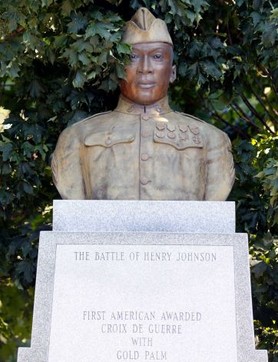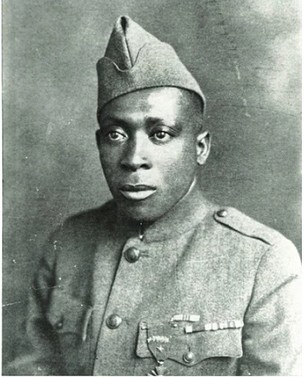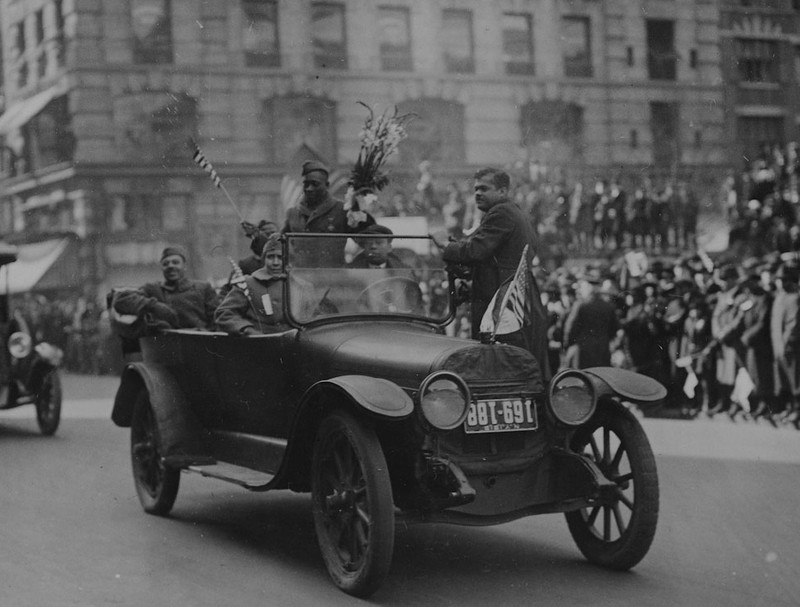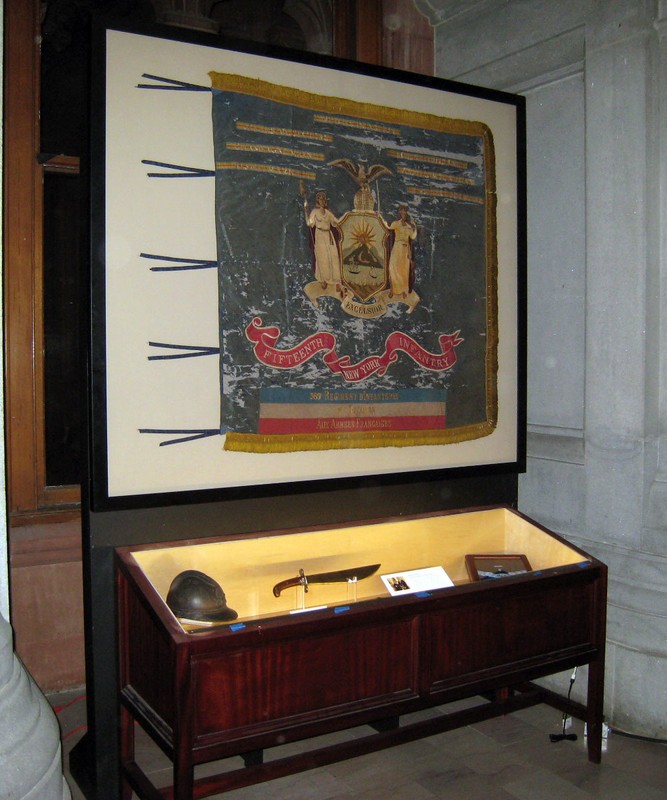Henry Johnson Memorial Statue-Washington Park
Introduction
Text-to-speech Audio
This monument in Washington Park commemorates African American soldier Henry Johnson (c.1892-1929), who served in World War I in the 368th Infantry, a regiment known as the "Harlem Hellfighters." In 2015, Johnson was posthumously awarded the Congressional Medal of Honor for his actions during the war. On the night of May 18, 1918, Johnson single-handedly turned back a German attack that saved the life of his comrade, Needham Roberts, and prevented the Germans from breaking the line. His actions garnered wide praise, including from former President Theodore Roosevelt who called Johnson one of the "five bravest Americans to serve in World War I." He was also the first American soldier to receive the Croix de Guerre (War Cross) from the French military during the war. Despite these accolades, Johnson, who suffered significant wounds in the attack, struggled to make a life for himself after returning home. He was buried in Arlington National Cemetery.
Images
The Henry Johnson Memorial Statue in Washington Park.

Henry Johnson (c.1892-1929) was posthumously awarded the Medal of Honor for his actions in 2015.

Johnson rode in a car that led the procession of the 369th Infantry Regiment after they returned from France in 1919.

This display in the New York State Capitol War Room contains Johnson's Medal of Honor, a French helmet like the one he wore, a U.S. Army-issued bolo knife, the 369th's regiments flag, and the regiment's patch.

Backstory and Context
Text-to-speech Audio
Johnson (his full name was William Henry Johnson) was born in 1892 in Winston Salem, North Carolina (the exact date of his birth is unknown). He moved to Albany, New York when he was a teenager and worked in a number jobs including as a chauffeur, soda mixer, laborer in a coal yard, and as a redcap porter at the Union Station. Johnson, who was 5'4'' and weighed 130 pounds, enlisted the U.S. Army on June 5, 1917 and joined Company C of the New York (Colored) National Guard, which later became the 369th Infantry Regiment (white officers commanded the regiment). When the 369th arrived in France in December, it did not receive combat training but was assigned to manual labor instead such as digging latrines and loading and unloading equipment. At the time, racism in the U.S. military (and in the United States) was pervasive; many in the armed forces doubted effectiveness African Americans soldiers and having them fight alongside white soldiers was inconceivable.
However, the French Army was desperate for soldiers and welcomed African American reinforcements, who wore the French helmet, uniform and jacket. The 369th was assigned to a colonial army unit of the French Fourth Army located on the front. The French sent the 369th, which would earn the nickname the "Harlem Hellfighters," to an outpost on the western edge of the Argonne Forest in Champagne region. Johson and his comrade, Needham Roberts, were on sentry duty in the night of May 18th. At 2am, they heard the approach of German soldiers. Roberts was wounded early in the attack and was only able to give Johnson hand grenades. Soon they ran out of grenades. Johnson was hit by bullets several times but continued shooting. After he ran out of bullets, he fought the Germans with his rifle until it splintered and then pulled out the remaining weapon he had, his bolo knife, and managed to kill four of the attackers (it was estimated he wounded 10 to 20 more Germans as well). He saved Robert's life and prevented the Germans from breaking through the line. Johnson's extraordinary actions made headlines in the United States and earned him the nickname the "Black Death."
When the 369th returned to America in February 1919, they paraded up Fifth Avenue to a heroes welcome. Johnson, who had been promoted to sergeant, led the procession in an open-top Cadillac car. The U.S. Army then sent Johnson on a tour, using his newfound fame to encourage others to enlist. However, according historian Thomas Saintourens, Johnson felt he was merely a "fairground attraction." He soon recognized his notoriety and service to his country did little to change people's attitude towards him as an African American man. In St. Louis, he expressed these feelings publicly during a conference. Some praised his honesty but others criticized him. The tour was no longer tenable as a result and Johnson left for Albany on the same day.
He had few employment options upon his return. He tried to work as a porter again but his injuries prevented him from continuing (his leg was shattered and held in place by a metal plate; he may have suffered from PTSD as well). Unable to make a living, he turned to alcohol. He did get married and had three children but they left him. Johnson died in a military hospital in 1929 and was thought to be buried in a pauper's field in Albany. This was a mistake. He was in fact buried with full military honors at Arlington National Cemetery. In addition to the Medal of Honor, Johnson also posthumously received the Distinguished Service Cross, the nation's second-highest military decoration, and the Purple Heart.
Sources
Grondahl, Paul. "Sgt. Henry Johnson clears key Medal of Honor hurdle." Times Union. May 15, 2014. https://www.timesunion.com/local/article/Sgt-Henry-Johnson-clears-key-Medal-of-Honor-5482160.php.
King, Gilbert. "Remembering Henry Johnson, the Soldier Called 'Black Death'.” Smithsonian Magazine. October 25, 2011. https://www.smithsonianmag.com/history/remembering-henry-johnson-the-soldier-called-black-death-117386701.
"Sergeant Henry Johnson." U.S. Army. Accessed January 23, 2024. https://www.army.mil/medalofhonor/johnson.
Trouillard, Stephanie. "Henry Johnson, Harlem soldier and forgotten WWI hero." France 24. May 14, 2018. https://www.france24.com/en/20180514-france-henry-johnson-harlem-soldier-forgotten-hero-world-war.
Wikimedia Commons
National Archives
